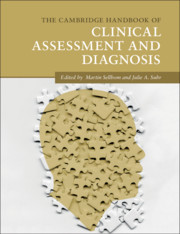Book contents
- The Cambridge Handbook of Clinical Assessment and Diagnosis
- The Cambridge Handbook of Clinical Assessment and Diagnosis
- Copyright page
- Contents
- Figures
- Tables
- Contributors
- Acknowledgments
- 1 Introduction to the Handbook of Clinical Assessment and Diagnosis
- Part I General Issues in Clinical Assessment and Diagnosis
- Part II Specific Clinical Assessment Methods
- Part III Assessment and Diagnosis of Specific Mental Disorders
- 21 Assessment of Childhood Neurodevelopmental Disorders
- 22 Assessment of Childhood Disruptive Behavior Disorders and Attention-Deficit/Hyperactivity Disorder
- 23 Assessment of Depressive Disorders and Suicidality
- 24 Assessment of Anxiety Disorders and Obsessive-Compulsive Disorder
- 25 Assessment of Trauma- and Stressor-Related Disorders
- 26 Assessment of People with Psychotic and Bipolar Disorders
- 27 Assessment of Eating Disorders
- 28 Assessment of Substance Use Disorders
- 29 Assessment of Personality Disorder
- 30 Neuropsychological Assessment of Dementia
- 31 Assessment of Traumatic Brain Injuries
- Part IV Clinical Assessment in Specific Settings
- Index
- References
23 - Assessment of Depressive Disorders and Suicidality
from Part III - Assessment and Diagnosis of Specific Mental Disorders
Published online by Cambridge University Press: 06 December 2019
- The Cambridge Handbook of Clinical Assessment and Diagnosis
- The Cambridge Handbook of Clinical Assessment and Diagnosis
- Copyright page
- Contents
- Figures
- Tables
- Contributors
- Acknowledgments
- 1 Introduction to the Handbook of Clinical Assessment and Diagnosis
- Part I General Issues in Clinical Assessment and Diagnosis
- Part II Specific Clinical Assessment Methods
- Part III Assessment and Diagnosis of Specific Mental Disorders
- 21 Assessment of Childhood Neurodevelopmental Disorders
- 22 Assessment of Childhood Disruptive Behavior Disorders and Attention-Deficit/Hyperactivity Disorder
- 23 Assessment of Depressive Disorders and Suicidality
- 24 Assessment of Anxiety Disorders and Obsessive-Compulsive Disorder
- 25 Assessment of Trauma- and Stressor-Related Disorders
- 26 Assessment of People with Psychotic and Bipolar Disorders
- 27 Assessment of Eating Disorders
- 28 Assessment of Substance Use Disorders
- 29 Assessment of Personality Disorder
- 30 Neuropsychological Assessment of Dementia
- 31 Assessment of Traumatic Brain Injuries
- Part IV Clinical Assessment in Specific Settings
- Index
- References
Summary
This chapter examines screening for depressive disorders and suicidality in clinical and in research contexts using self-report measures. The chapter provides an overview of various definitions of the respective depression and suicidality constructs and addresses assessment issues that have particular relevance to their measurement, including willingness to disclose symptoms; generalizability across cultures; practicality; and psychometric properties. These widely used instruments were reviewed: The Beck Depression Inventory – II (BDI-II), the Center for Epidemiologic Studies Depression Scale-Revised (CESD-R), the Patient Health Questionnaire – 9 (PHQ – 9), the Profile of Mood States 2 (POMS 2), the Beck Scale for Suicide Ideation (BSS), the Suicidal Behaviors Questionnaire – Revised (SBQ-R), and the Adult Suicidal Ideation Questionnaire (ASQ). Summaries of the comparative features of these depression and suicidality scales are provided in tables.
Keywords
- Type
- Chapter
- Information
- The Cambridge Handbook of Clinical Assessment and Diagnosis , pp. 317 - 329Publisher: Cambridge University PressPrint publication year: 2019
References
- 1
- Cited by



